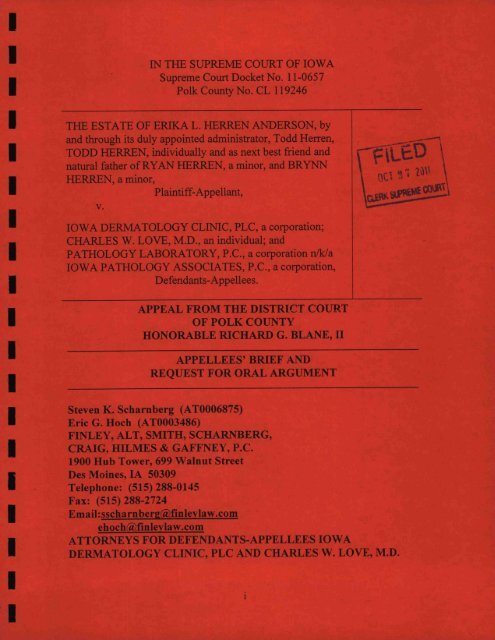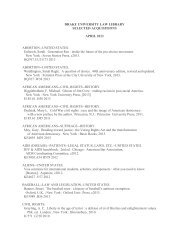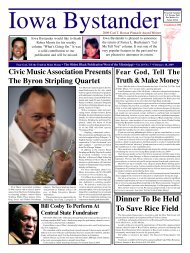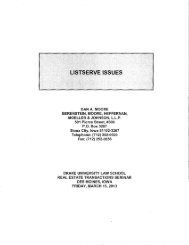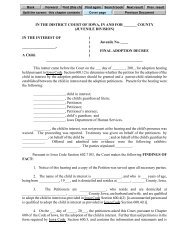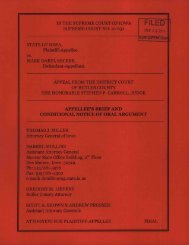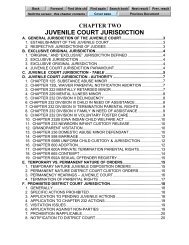Appellee Brief for Iowa Dermatology
Appellee Brief for Iowa Dermatology
Appellee Brief for Iowa Dermatology
- No tags were found...
Create successful ePaper yourself
Turn your PDF publications into a flip-book with our unique Google optimized e-Paper software.
CERTIFICATE OF COMPLIANCE WITH TYPE-VOLUMELIMITATION, TYPEFACE REQUIREMENTS, AND TYPE-STYLEREQUIREMENTS1. This brief complies with the type-volume limitation of <strong>Iowa</strong> R. App. P.6.903(1 )(g)(l) because this brief contains 5,301 words, excluding the parts ofthe brief exempted by <strong>Iowa</strong> R. App. P. 6.903(1 )(g)(l).2. This brief complies with the typeface requirements of <strong>Iowa</strong> R. App. P.6.903(l)(e) and the type-style requirements of <strong>Iowa</strong> R. App. P. 6.903(l)(f)because this brief has been prepared in proportionally spaced typeface usingMicrosoft Office Word 2007 in 14-point Times New Roman.. ^4^fSteven K. Scharnberg (AT0006875)Eric G. Hoch (AT0003486)FINLEY, ALT, SMITH, SCHARNBERG,CRAIG, HILMES & GAFFNEY, P.C.1900 Hub Tower, 699 Walnut StreetDes Moines, IA 50309Telephone: (515)288-0145Fax: (515)288-2724Email: ehoch(a>fmlevlaw. comsschamberg@finleylaw.comATTORNEYS FOR DEFENDANTS-APPELLEES IOWA DERMATOLOGYCLINIC, PLC AND CHARLES W. LOVE,M.D.iii
CERTIFICATE OF SERVICEIt is hereby certified that on the 27th day of October, 2011, theundersigned or a person acting on his behalf did serve the attached copy ofDefendant-<strong>Appellee</strong>s' <strong>Brief</strong> on the other parties to this appeal by mailing a copythereof to the following counsel of record:Marc A. HumphreyAlan O. OlsonTyler C. PatrickOlson Law Firm, P.C.Humphrey Law Firm, P.C. 3116 Ingersoll Avenue2755 - 106 th Street Des Moines, IA 50312Urbandale,IA 50322ATTORNEYS FOR PLAINTIFF-APPELLANTMichael W. EllwangerRawlings, Nieland, Killinger, Ellwanger, Jacobs,Mohrhauser, Nelson, & Early, LLP522 - 4 th Street, Suite 300Sioux City, IA 51101ATTORNEYS FOR DEFENDANT-APPELLEE PATHOLOGYASSOCIATES, P.C.4,Steven K. Scharnberg (AT0006875)Eric G. Hoch (AT0003486)FINLEY, ALT, SMITH, SCHARNBERG,CRAIG, HILMES & GAFFNEY, P.C.1900 Hub Tower, 699 Walnut StreetDes Moines, IA 50309Telephone: (515)288-0145Fax: (515)288-2724Email :ehoch@finleylaw.comsscharnberg@finleylaw.comATTORNEYS FOR DEFENDANTS-APPELLEES IOWA DERMATOLOGYCLINIC, PLC & CHARLES LOVE, M.D.iv
ATTORNEY'S COST CERTIFICATEI, Eric G. Hoch, hereby certify that the actual cost of reproducing thenecessary copies of the preceding <strong>Brief</strong> consisting of 35 pages was$ / 3 /, 7 \o , and that amount has been actually paid in full by thisattorney's firm.Steven K. Scharnberg (AT0006875)Eric G. Hoch (AT0003486)FINLEY, ALT, SMITH, SCHARNBERG,CRAIG, HILMES & GAFFNEY, P.C.1900 Hub Tower, 699 Walnut StreetDes Moines, IA 50309Telephone: (515)288-0145Fax: (515)288-2724Email :ehoch@finleylaw.comsscharnberg@finleylaw.comATTORNEYS FOR DEFENDANTS-APPELLEES IOWA DERMATOLOGYCLINIC, PLC & CHARLES LOVE, M.D.
TABLE OF CONTENTSCERTIFICATE OF FILINGCERTIFICATE OF COMPLIANCECERTIFICATE OF SERVICEATTORNEY'S COST CERTIFICATETABLE OF AUTHORITIESSTATEMENT OF ISSUES PRESENTED FOR REVIEWiiiiiivvvmxI. ROUTING STATEMENT 1II. STATEMENT OF THE CASE 1III. STATEMENT OF THE FACTS 1ARGUMENT 3I. The District Court did not err in granting Defendants' motions <strong>for</strong>summary judgment based on <strong>Iowa</strong> Code section 614.1(9)(a)'s statuteof repose because there are no genuine issues of material fact and thedoctrine of equitable estoppel is inapplicable 31(A) Preservation of Issue <strong>for</strong> Review 31(B) Standard of Review 31(C) The District Court did not err in granting Defendants' motions <strong>for</strong>summary judgment based on <strong>Iowa</strong> Code section 614.1(9)(a)'s statute ofrepose because there are no genuine issues of material fact and the doctrineof equitable estoppel is inapplicable 31(C)(1) Plaintiffs correctly admit that if the Statute of Repose isapplicable, then Plaintiffs are precluded from bringing any cause of action<strong>for</strong> a negligent act six years after the occurrence of that act 3vi
1(C)(2) The doctrine of equitable estoppel is inapplicable in this case 81(C)(2)(a) These Defendants have not made a false representation orconcealed material facts 91(C)(2)(b) These Defendants have not made a false representation orconcealed material facts 16II.The District Court did not err in granting Defendants' motions <strong>for</strong>summary judgment based on <strong>Iowa</strong> Code section 614.1(9)(a)'s statuteof repose because there are no genuine issues of material fact and theso-called continuum of negligent care doctrine did not delaycommencement of state of repose 1711(A) Preservation of Issue <strong>for</strong> Review 1711(B) Standard of Review 1711(C) The District Court did not err in granting Defendants' motions <strong>for</strong>summary judgment based on <strong>Iowa</strong> Code section 614.1(9)(a)'s statute ofrepose because there are no genuine issues of material fact and the doctrineof equitable estoppel is inapplicable 17II(C)(a) The District Court did not err because <strong>Iowa</strong> Courts have not andshould not adopt the so-called continuous negligent treatment doctrine orthe so-called continuum of negligent treatment doctrine with relation to astatute of repose such as the six-year statute of repose in <strong>Iowa</strong> Codesection 614.1(9) .- 17.II(C)(b) The District Court did not err because even if this Court adoptsthe so-called continuous negligent treatment doctrine or the so-calledcontinuum of negligent treatment doctrine with relation to a statute ofrepose such as the six-year statute of repose in <strong>Iowa</strong> Code section614.1(9), it is not applicable in this case 21CONCLUSION ...23REQUEST FOR ORAL ARGUMENT 24vii
TABLE OF AUTHORITIESCASESAlbrecht v. Gen. Motors Corp., 648 N.W.2d 87 (<strong>Iowa</strong> 2002) 6,7,18,20Barnes v. Bovenmyer, 122N.W.2d 312 (<strong>Iowa</strong> 1963) 14Bensman v. United States Forest Serv., 408 F.3d 945 (7th Cir. 2005) 9Bob McKiness Excavating & Grading, Inc. v. Morton Bldgs., Inc., 507N.W.2d 405 (<strong>Iowa</strong> 1993) 6,20Borderlon v. Peck, 661 S.W.2d 907 (Tex.1983) 8Bryant v. Rankin, 468 F.2d 510 (8th Cir. 1972) 15Buckroyd v. Bunten, 237 N.W.2d 808 (<strong>Iowa</strong> 1976) 15Christy v. Miulli, 692 N.W.2d 694 (<strong>Iowa</strong> 2005) 8-10,20Cole v. Hart<strong>for</strong>d Accident & Indem. Co., 46 N.W.2d 811 (<strong>Iowa</strong> 1951).... 10Cronin v. Hagan, 221 N.W.2d 748 (<strong>Iowa</strong> 1974) 14Cunningham v. Huffman, 609 N.E.2d 321, 325 (111. 1993) 21Dierking v. Bellas Hess Superstore, Inc., 258 N.W.2d 312 (<strong>Iowa</strong> 1977) ..9Donovan v State, 445 N.W.2d 763 (<strong>Iowa</strong> 1989) 14Grams v. Renner, 2009 WL 2184826, (<strong>Iowa</strong> Ct. App. 2009)(unpublished) 10Grismore v. Garber, 2006 WL 469986 (<strong>Iowa</strong> Ci. App. 2006)(unpublished) 10,11Harrison v. Bevilacqua, 580 S.E.2d 109 (S.C. 2003) 21Hook v. Lippolt, 755 N.W.2d 514 (<strong>Iowa</strong> 2008) 8Kennis v. Mercy Hosp. Med. Center, 491 N.W.2d 161 (<strong>Iowa</strong> 1992) 15Kohrt v. Yetter, 344 N.W.2d 245 (<strong>Iowa</strong> 1984) 20Koppes v. Pearson, 384 N.W.2d 381 (<strong>Iowa</strong> 1986) 20Langner v. Simpson, 533 N.W.2d 511 (<strong>Iowa</strong> 1995) 9,19,22McCleeary v. Wirtz, 222 N.W.2d 409 (<strong>Iowa</strong> 1974) 14McClendon v. Beck, 569 N.W.2d 382 (<strong>Iowa</strong> 1997) 9Meier v. Alfa-Laval, Inc., 454 N.W.2d 576 (<strong>Iowa</strong> 1990) 8Murtha v. Cahalan, 745 N.W.2d 711 (<strong>Iowa</strong> 2008) 5,19Oswald v. LeGrand, 453 N.W.2d 634 (<strong>Iowa</strong> 1990) 15Pauscher v. <strong>Iowa</strong> Meth. Med. Ctr., 408 N.W.2d 355 (<strong>Iowa</strong> 1987) 14Perin v. Hayne, 210 N.W.2d 609 (<strong>Iowa</strong> 1973) 15Rathje v. Mercy Hospital, 745 N.W.2d 443 (<strong>Iowa</strong> 2008) 5Rudenauer v. Zafiropoulos, 837 N.E.2d 278 (Mass. 2005) 21Sant Amour v. Hermanson, 2009 WL 778107 (<strong>Iowa</strong> Ct. App. 2009)(unpublished) 4,5,6viii
Schlote v. Dawson, 676 N.W.2d 187 (<strong>Iowa</strong> 2004) 10Schulte v. Wageman, 465 N.W.2d 285 (<strong>Iowa</strong> 1991) 18Steffes v. Bruner, 2008 WL 5412226 (<strong>Iowa</strong> Ct. App. 2008)(unpublished) 10Ulrich v. Veterans Admin. Hosp., 853 F.2d 1078 (2d Cir. 1988). 19Van Overbeke v. Youberg, 540 N.W.2d 273 (<strong>Iowa</strong> 1995) 10,11Welte v. Bello, 482 N.W.2d 437 (<strong>Iowa</strong> 1992) 15STATUTES/TREATIES/RULES<strong>Iowa</strong> Code § 614.1(9) (2009) 2-4,6,7,17-19,21<strong>Iowa</strong> R. App. P. 6.1101(3) 1OTHER SOURCESMalpractice Insurance Study Committee, Report to Sixty-Sixth <strong>Iowa</strong>Gen. Assembly (Jan. 1976) 20ix
STATEMENT OF ISSUES PRESENTED FOR REVIEWI. WHETHER THE DISTRICT COURT ERRED IN GRANTING DEFENDANTS'MOTIONS FOR SUMMARY JUDGMENT BASED ON IOWA CODESECTION614.1(9)(A)'S STATUTE OF REPOSE BECAUSE THERE ARE NO GENUINE ISSUES OFMATERIAL FACT AND THE DOCTRINE OF EQUITABLE ESTOPPEL ISINAPPLICABLE.CASESAlbrecht v. Gen. Motors Corp., 648 N.W.2d 87 (<strong>Iowa</strong> 2002)Barnes v. Bovenmyer, 122 N.W.2d 312 (<strong>Iowa</strong> 1963)Bensman v. United States Forest Serv., 408 F.3d 945 (7th Cir. 2005)Bob McKiness Excavating & Grading, Inc. v. Morton Bldgs., Inc., 507N.W.2d405 (<strong>Iowa</strong> 1993)Borderlon v. Peck, 661 S.W.2d 907 (Tex. 1983)Bryant v. Rankin, 468 F.2d 510 (8th Cir. 1972)Buckroyd v. Bunten, 237 N.W.2d 808 (<strong>Iowa</strong> 1976)Christy v. Miulli, 692 N.W.2d 694 (<strong>Iowa</strong> 2005)Cole v. Hart<strong>for</strong>d Accident & Indem. Co., 46 N.W.2d 811 (<strong>Iowa</strong> 1951)Cronin v. Hagan, 221 N.W.2d 748 (<strong>Iowa</strong> 1974)Dierking v. Bellas Hess Superstore, Inc., 258 N.W.2d 312 (<strong>Iowa</strong> 1977)Donovan v State, 445 N.W.2d 763 (<strong>Iowa</strong> 1989)Grismore v. Garber, 2006 WL 469986 (<strong>Iowa</strong> Ct. App. 2006) (unpublished)Hook v. Lippolt, 755 N.W.2d 514 (<strong>Iowa</strong> 2008)Kennis v. Mercy Hosp. Med. Center, 491 N.W.2d 161 (<strong>Iowa</strong> 1992)Langner v. Simpson, 533 N.W.2d 511 (<strong>Iowa</strong> 1995)McCleeary v. Wirtz, 222 N.W.2d 409 (<strong>Iowa</strong> 1974)McClendon v. Beck, 569 N.W.2d 382 (<strong>Iowa</strong> 1997)Meier v. Alfa-Laval, Inc., 454 N.W.2d 576 (<strong>Iowa</strong> 1990)Murtha v. Cahalan, 745 N.W.2d 711 (<strong>Iowa</strong> 2008)Oswald v. LeGrand, 453 N.W.2d 634 (<strong>Iowa</strong> 1990)Pauscher v. <strong>Iowa</strong> Meth. Med. Ctr., 408 N.W.2d 355 (<strong>Iowa</strong> 1987)Rathje v. Mercy Hospital, 745 N.W.2d 443 (<strong>Iowa</strong> 2008)Sant Amour v. Hermanson, 2009 WL 778107 (<strong>Iowa</strong> Ct. App. 2009)Schlote v. Dawson, 676 N.W.2d 187 (<strong>Iowa</strong> 2004)Van Overbeke v. Youberg, 540 N.W.2d 273 (<strong>Iowa</strong> 1995)Welte v. Bello, 482 N.W.2d 437 (<strong>Iowa</strong> 1992)
I. ROUTING STATEMENTThis case involves the questions of application of existing legal principlesand issues appropriate <strong>for</strong> summary disposition. There<strong>for</strong>e, this case should betransferred to the <strong>Iowa</strong> Court of Appeals. IOWA R. APP. P. 6.1101(3).n. STATEMENT OF THE CASElowa <strong>Dermatology</strong> Clinic, PLC and Dr. Love agree with Plaintiffs'statement of the case.III.STATEMENT OF THE FACTSPlaintiffs filed this alleged medical malpractice action on or about August10, 2010.In paragraphs 7, 8, 9, 10, 18, 19 and 21 of Plaintiffs' Petition, Plaintiffsallege the factual basis <strong>for</strong> Plaintiffs' lawsuit and specifically list the followingdates of treatment: September 18, 1996, January 2, 1997, February 15, 1997,June 3, 1997, July 8, 1997, July 25, 1997, July 30, 1997, August 7, 1997,August 8,1997, August 11,1997, January 27,1998, January 28,1998, February28, 1998, March 6, 1998, August 18, 1998, September 4, 1998, September 10,1998, September 15, 1998, March 2,1999, April 1,1999, April 6,1999, April 9,1999, April 14,1999, April 15,1999, April 23,1999, July 19,1999, August 24,1999, October 4, 1999, November 9, 1999, September 26, 2000, August 28,1
2002, September 10,2002, March 15,2004, September 15,2004, June 14,2006,and September 6, 2007.Of all the dates of treatment listed in the paragraph immediately above,only care and treatment provided on September 15, 2004, June 14, 2006 andSeptember 6, 2007 occurred within six years of the filing ofthis lawsuit. TheStatute of Repose found in <strong>Iowa</strong> Code Section 614.1(9) (2009) provides in partthat "In no event shall any action be brought more than six years after the dateon which occurred the act or omission or occurrence alleged in the action tohave been a cause of the injury or death..." (614.1 (9)(a)).It is admitted that Plaintiff Erika Herren Anderson was a patient ofDefendant <strong>Iowa</strong> <strong>Dermatology</strong> Clinic, PLC end Dr. Love saw her sporadically<strong>for</strong> approximately ten years. Todd Herren was not present during the twenty-sixvisits to Dr. Love by Plaintiff Erika Herren Anderson and there<strong>for</strong>e has no-personal knowledge about conversations between her and Dr. Love. (App, p.357).While Dr. Love examined slides, if a melanoma or an atypical looking.pigmented lesion were present, he would not diagnose it himself. (App. p. 358).If there was a significantly atypical mole, abnormal looking mole, or an atypicallooking pigmented lesion, Dr. Love would send that specimen to a trusted2
pathologist <strong>for</strong> a consultation, interpretation, or a second opinion. (App. p.358).ARGUMENTI. THE DISTRICT COURT DID NOT ERR IN GRANTING DEFENDANTS'MOTIONS FOR SUMMARY JUDGMENT BASED ON IOWA CODE SECTION614.1(9)(A)'S STATUTE OF REPOSE BECAUSE THERE ARE NO GENUINEISSUES OF MATERIAL FACT AND THE DOCTRINE OF EQUITABLEESTOPPEL IS INAPPLICABLE.1(A) Preservation of Issue <strong>for</strong> Review<strong>Iowa</strong> <strong>Dermatology</strong> Clinic, PLC and Dr. Love agree that error has beenpreserved on this issue.1(B) Standard of Review<strong>Iowa</strong> <strong>Dermatology</strong> Clinic, PLC and Dr. Love agree with Plaintiffs'characterization of the standard of review.1(C) The District Court did not err in granting Defendants' motions <strong>for</strong>summary judgment based on <strong>Iowa</strong> Code section 614.1(9)(a)'s statute ofrepose because there are no genuine issues of material fact and the doctrineof equitable estoppel is inapplicable.1. Plaintiffs correctly admit that if the Statute of Repose is applicable,then Plaintiffs are precluded from bringing any cause of action <strong>for</strong> anegligent act six years after the occurrence of that act.Plaintiffs correctly admit that if the Statute of Repose is applicable, thenPlaintiffs are precluded from bringing any cause of action <strong>for</strong> a negligent act six
years after the occurrence of that act. The statute of repose found in <strong>Iowa</strong> CodeSection 614.1(9) (2009) bars all claims based upon care and treatment of thePlaintiff Erika Herren Anderson more than six years prior to the filing ofPlaintiffs' Petition.<strong>Iowa</strong> Code Section 614.1(9) (2009) provides:9. Malpractice (a). Except as provided in paragraph (b), thosefounded on injuries to the person or wrongful death against anyphysician and surgeon, osteopath, osteopathic physician andsurgeon, dentist, podiatric physician, optometrist, pharmacist,chiropractor, physician assistant, or nurse, licensed under chapter147, or a hospital licensed under chapter 135B, arising out ofpatient care, within two years after the date on which the claimantknew, or through the use of reasonable diligence should haveknown, or received notice in writing of the existence of, the injuryor death <strong>for</strong> which damages are sought in the action, whichever ofthe dates occurs first, but in no event shall any action be broughtmore than six years after the date on which occurred the act oromission or occurrence alleged in the action to have been thecause of the injury or death unless a <strong>for</strong>eign object unintentionallyleft in the body caused the injury or death. (Emphasis added.)Sant Amour v. Dr. Hermanson, 2009 WL 778107 (<strong>Iowa</strong> Ct. App. 2009)(unpublished) is a case factually similar to this case. In Sant Amour, thedefendant doctor had seen the plaintiff patient several times <strong>for</strong> examinationsover a period of years during which time the doctor failed to diagnose thepatient's brain tumor. Some of the patient visits in question occurred more thansix years prior to the filing of the lawsuit, and other visits occurred within sixyears of the filing of the lawsuit. The Sant Amour District Court granted4
summary judgment on all claims against the doctor based on the statute ofrepose, and the <strong>Iowa</strong> Court of Appeals held that only those claims <strong>for</strong> examsoccurring more than six years prior to the filing of the lawsuit should have beendismissed. (The Court also reversed that portion ofthe District Court's rulinggranting surnmary judgment based on the statute of limitations because the <strong>Iowa</strong>Supreme Court rendered the Rathje v. Mercy Hospital, 745 N.W.2d 443 (<strong>Iowa</strong>2008) and Murtha v. Cahalan, 745 N.W.2d 711 (<strong>Iowa</strong> 2008) cases clarifying thelaw concerning what triggers the running of the statute of limitations after theappeal had been filed. The parties agreed that there was a genuine issue ofmaterial fact concerning when the statute of limitations commenced as it relatedto care and treatment of the plaintiff by the defendant within six years of thefiling of the lawsuit.)In affirming the dismissal of all claims based on contact between theplaintiff and the defendant occurring more than six years prior to the filing ofthe lawsuit the Court in Sant Amour stated:Statute of Repose. <strong>Iowa</strong> law distinguishes between statutes oflimitations and statutes of repose:"Statutes of repose are different from statutes oflimitation, although they have comparable effects."A statute of limitations bars, after a certain period oftime, the right to prosecute an accrued cause ofaction.5
By contrast, a statute of repose "terminates any rightof action after a specified time has elapsed, regardlessof whether or not there has as yet been an injury."A statute of repose period begins to run from theoccurrence of some event other than the event of aninjury that gives rise to a cause of action and,there<strong>for</strong>e, bars a cause of action be<strong>for</strong>e the injuryoccurs.Under a statute of repose, there<strong>for</strong>e, the mere passageof time can prevent a legal right from ever arising.Bob McKiness Excavating & Grading, Inc. v. Morton Bldgs., Inc.,507 N.W.2d 405, 408 (<strong>Iowa</strong> 1993) (citations omitted).2009 WL 778107 at 2.* * *The statute sets limits on medical malpractice actions and includesboth a statute of limitations and a statute of repose. See Albrecht v.Gen. Motors Corp., 648 N.W.2d 87, 92 (<strong>Iowa</strong> 2002). Theemphasized statutory language quoted sets a six-year time limit <strong>for</strong>commencing an action that runs from "the date on which occurredthe act or omission or occurrence alleged in the action to have beenthe cause of the injury or death." <strong>Iowa</strong> Code § 614.1 (9)(a). Thefocus is not on the claimed injury, but rather on "the act oromission or occurrence" and does not require that a claim haveaccrued or that an injury have been discovered. Albrecht, 648N.W.2d at 92 (citing Bob McKiness Excavating, 507 N.W.2d at408).2009 WL 778107 at *3.Just as the Court did in the Sant Amour case, the District Court in thismatter properly granted summary judgment on all claims related to care andtreatment provided more than six- years prior to the filing of this lawsuit.6
648 N.W.2 at 91-92.2. The doctrine of equitable estoppel is inapplicable in this case.To establish equitable estoppel, a plaintiff must prove by clear andconvincing evidence:(1) The defendant has made a false representation or has concealedmaterial facts;(2) the plaintiff lacks knowledge of the true facts;(3) the defendant intended the plaintiff to act upon suchrepresentations; and(4) the plaintiff did in fact rely upon such representations to hisprejudice.Hook v. Lippolt, 755 N.W.2d 514, 524-25 (<strong>Iowa</strong> 2008) (emphasis added)(citing Christy v. Miulli, 692 N.W.2d 694, 702 (<strong>Iowa</strong> 2005))."This doctrine is intended to prevent a party from benefiting from 'theprotection of a limitations statute when by his own fraud he has prevented theother party from seeking redress within the period of limitations.'" Christy, 692N.W.2d at 702 (quoting Borderlon v. Peck, 661 S.W.2d 907, 909 (Tex. 1983))."Conduct amounting to false representation or concealment needs to bedeceptive or fraudulent." Meier v. Alfa-Laval, Inc., 454 N.W.2d 576,580 (<strong>Iowa</strong>1990). To establish deceptive or fraudulent conduct, there must be proof the8
defendant acted "with the intent to mislead the injured party." Id.; accordDierking v. Bellas Hess Superstore, Inc., 258 N.W.2d 312, 316 (<strong>Iowa</strong> 1977)(requiring proof defendant "knowingly took a position with the intention that itbe acted upon"); see also Bensman v. United States Forest Serv., 408 F.3d 945,965 (7th Cir. 2005) (equitable estoppel requires a showing the defendant"engaged in affirmative misconduct rather than mere negligence").a. These Defendants have not made a false representation orconcealed material facts.Under the first element, with the context of "a modern medicalmalpractice action, the plaintiff carries the burden of either (1) proving that thedefendant affirmatively concealed the facts on which the plaintiff wouldpredicate [the] cause of action," or (2) proving a confidential or fiduciaryrelationship exists between the person concealing the cause of action and theaggrieved party combined with proof that defendant breached the duty ofdisclosure." McClendon v. Beck, 569 N.W.2d 382,385 (<strong>Iowa</strong> 1997) (quotationsomitted) (citing Langner v. Simpson, 533 N.W.2d 511, 522 (<strong>Iowa</strong> 1995)).However, "a party relying on the doctrine of fraudulent concealment must provethe defendant did some affirmative act to conceal the plaintiffs cause of actionindependent of and subsequent to the liability-producing conduct." Christy, 692N.W.2d at 702. The alleged acts of concealment must be "independent of the9
alleged act relied on to establish liability." Van Overbeke, 540 N.W.2d at 276;Cole v. Hart<strong>for</strong>d Accident & Indent. Co., 242 <strong>Iowa</strong> 416, 428-29, 46 N.W.2d811, 818 (1951). For a claim of fraudulent concealment, "there must be a'temporal separation of the acts of negligence and the acts of allegedconcealment; the concealment must take place after the alleged acts ofnegligence occurred. Grams v. Renner, 2009 WL 2184826, *3 (<strong>Iowa</strong> Ct. App.2009) (unpublished) (citing Schlote, 676 N.W.2d at 195 (<strong>Iowa</strong> 2004); VanOverbeke v. Youberg, 540 N.W.2d 273, 276 (<strong>Iowa</strong> 1995)); Stejfes v. Bruner,2008 WL 5412226, *5 (<strong>Iowa</strong> Ct. App. 2008) (unpublished).Moreover, silence does not by itself establish suppression or concealmentif there is no alleged negligent act independent from the silence. Grismore v.Garber, 715 N.W.2d 767, No. 04-1801,2006 WL 469986 *3, *5 (<strong>Iowa</strong>Ct. App.March 1, 2006) (unpublished) (citing Van Overbeke, 540 N.W.2d at 276;Schlote v. Dawson, 676 N.W.2d 187 (<strong>Iowa</strong> 2003), overruled on other groundsby Christy, 692 N.W.2d at 700-04). That is, despite a special relationship"which calls <strong>for</strong> a reduced level of proof of fraudulent concealment, the acts ofconcealment must nevertheless be independent of the alleged acts relied on toestablish liability. There must also be a temporal separation of the acts ofnegligence and the acts of alleged concealment; the concealment must take placeafter the alleged acts of negligence occurred." Grismore, 715 N.W.2d 767 at *310
(citing Van Overbeke, 540 N. W.2d at 276). Otherwise, in cases where there is aspecial relationship where an attorney, physician, or similar other personnegligently fails to disclose or communicate a matter, the statute of limitationsor statute of repose would cease to have any meaning. Grismore, 715 N.W.2d767 at *3; Van Overbeke, 540 N.W.2d at 276.Plaintiffs claim the following satisfy their burden of proving, by clear andconvincing evidence, that these Defendants have made a false representation orhave concealed material facts:21. The Defendants never explained to Erika Herren Anderson thatthe slides created as a result of the many biopsies that Erika had toundergo were often times being reviewed in-house by Dr. Love, adermatologist, and not a pathology lab by a board certifiedpathologist. (Affidavit of Todd Herren p. 2; App. 10).22. At the time ofher treatment, Erika Herren Anderson was notmade aware by the Defendants that in February, 1998 skin excisedfrom her body was sent to Defendant Pathology Associates <strong>for</strong> thepurpose of creating a slide, but was not interpreted by a boardcertified pathologist while at the pathology lab and was insteadreviewed only by Dr. Love, a dermatologist. (Affidavit of ToddHerren p. 2; App. 10).* * *24. At the time ofher treatment, the Defendants failed to explain toPlaintiffs the significance of the differences in the training andqualifications of a dermatologist as compared to a pathologist as itrelates to the interpretation of biopsy slides <strong>for</strong> the presence ofcancer. (Affidavit of Todd Herren p. 2; App. 10).(App. pp. 94-95).11
Despite these claims, Plaintiffs did not support their Resistance with anyadmissible evidence to satisfy their burden <strong>for</strong> proving fraudulent concealmentor that a misrepresentation was made. To wit, Plaintiffs claimed that:» the Defendants never explained to Ms. Herren Anderson that theslides "were often times being reviewed in-house by Dr. Love, adermatologist, and not a pathology lab by a board certifiedpathologist." (App. p. 278); and• at the time of her treatment, Ms. Herren Anderson was not madeaware of the fact that at least on one occasion the skin excisedfrom Erika was sent to a pathology lab <strong>for</strong> the purpose of creatinga slide, but was not interpreted by a board certified pathologistwhile at the pathology lab. (App. p. 278).As an initial matter, there is no temporal separation between the allegedacts of concealment and the allegedly negligent care provided to Plaintiff ErikaHerren Anderson. Pursuant to the above-cited authorities, all claims ofequitable estoppel based upon fraudulent concealment must fail. Moreover,Plaintiff Todd Herren simply does not have personal knowledge of whether anysuch statements were made to the actual patient, Plaintiff Erika HerrenAnderson. Moreover, Plaintiffs have no evidence (permissible to defeat a12
properly supported motion <strong>for</strong> summary judgment) to refute the depositiontestimony of Dr. Love establishing disclosure of the preceding allegations:Q. Did you ever have any discussions with Erika wherein youadvised her that you were not sending tissue specimens out to apathology lab <strong>for</strong> evaluation, but instead that you were evaluatingthem in-house?A. Yes. That is my customary practice.Q. Tell me about that. What would you have said to her?A. I would have said that "I will check this biopsy <strong>for</strong> youpersonally," and if I were going to send it to the pathology lab, Iwould say "I will have our pathologist check this <strong>for</strong> you."Q. Okay. So it's your testimony that both Erika and Todd— WasTodd ever present when you saw her?A. At this time, I don't recall that he ever was present during avisit.Q. Okay. But it's your testimony that at least Erika would havebeen aware of the distinction between you interpreting slidesversus the pathologist at Pathology Labs, P.C, interpreting herslides?A. That's correct, because I would never mention a specific labthat I was sending them to.(App. p. 357).With regard to the alleged non-disclosure of the training andqualifications of Dr. Love to examine slides, such allegations are both13
misleading and immaterial. They are misleading because as Dr. Love testified,while he examined slides, if a melanoma or an atypical looking pigmentedlesion were present, he would not diagnose it himself. (App. p. 358). Rather, ifthere was a significantly atypical mole, abnormal looking mole, or an atypicallooking pigmented lesion, Dr. Love would send that specimen to a trustedpathologist <strong>for</strong> a consultation, interpretation, or a second opinion. (App. p.358).Moreover, despite Plaintiffs argument that the "patient rule" andPauscher v. <strong>Iowa</strong> Meth Med. Ctr., 408 N.W.2d 355 (<strong>Iowa</strong> 1987) imbuedPlaintiff Erika Herren Anderson with a "right to know" who was per<strong>for</strong>minganalysis on biopsied tissue, the alleged non-disclosure of the training andqualifications of Dr. Love to examine slides is immaterial.Plaintiffs areattacking these Defendants' credentials and qualifications to provide the medicalcare rendered to Plaintiff Erika Herren Anderson. Since a lay jury is not able to<strong>for</strong>m an opinion on the complexity of factors impacting the ability to per<strong>for</strong>m acertain procedure, expert testimony must be offered to enable the jury tounderstand the medical staffs committee's findings, evaluations, or opinions togrant or deny privileges <strong>for</strong> a particular procedure. Donovan v State, 445N.W.2d 763, 766 (<strong>Iowa</strong> 1989); McCleeary v. Wirtz, 222 N.W.2d 409,413 (<strong>Iowa</strong>1974); accord Cronin v. Hagan, 221 N.W.2d 748, 755 (<strong>Iowa</strong> 1974); Barnes v.14
Bovenmyer, 122 N.W.2d 312, 317 (1963). Further, only experts can establishthe applicable standard of care and skill required of a medical professional in amedical negligence action. Oswald v. LeGrand, 453 N.W.2d 634, 635 (<strong>Iowa</strong>1990) ("[ejvidence of the applicable standard of care - and its breach - must befurnished by an expert."); Kennis v. Mercy Hosp. Med. Center, 491 N.W.2d161,165 (<strong>Iowa</strong> 1992); Weltev. Bello, 482N.W.2d437,439 (<strong>Iowa</strong> 1992); Perinv. Hayne, 210 N.W.2d 609, 613 (<strong>Iowa</strong> 1973). Expert testimony regarding thelack of skill or care there<strong>for</strong>e is necessary support of a verdict. Buckroyd v.Bunten, 237 N.W.2d 808, 812 (<strong>Iowa</strong> 197'6); Bryant v. Rankin, 468 F.2d 510, 513(8th Cir. 1972).Plaintiffs have designated no experts who will testify as to standard ofcare or causation with regard to a claim that Dr. Love was not qualified toper<strong>for</strong>m the tissue analysis described above. (See Pis.' Expert Designation).Accordingly, Plaintiffs cannot prove negligence, causation, or materiality on thisissue. There<strong>for</strong>e, whether these Defendants were medically qualified to per<strong>for</strong>mthe tissue analysis described above is immaterial to the disposition of thismatter. These Defendants did not fail to disclose any material facts to Plaintiffs,and Plaintiffs cannot satisfy their burden of proof on the first element ofequitable estoppel.15
. These Defendants did not intend <strong>for</strong> Plaintiffs to act upon anyallegedly false misrepresentations.Plaintiffs have no proof that these Defendants intended Plaintiffs todetrimentally rely upon their silence as to Dr. Love's provision of medical care.As explained above, the undisputed evidence that may permissibly support orresist a motion <strong>for</strong> summary judgment proves that Dr. Love freely in<strong>for</strong>medPlaintiff Erika Herren Anderson when he reviewed the slides, and that hein<strong>for</strong>med Plaintiff Erika Herren Anderson when the slides were sent to apathologist.Moreover, Plaintiffs have no evidence that these Defendantsintended Plaintiff Erika Herren Anderson to take, or not take, any actions basedupon representations regarding his qualifications. Indeed, Plaintiffs' ownexperts are not offering opinions critical of Dr. Love not in<strong>for</strong>ming PlaintiffErika Herren Anderson of the relative qualifications of dermatologists and boardcertified pathologists as they relate to the slide examination that occurred in thiscase. There is simply no evidence that these Defendants intended to lullPlaintiffs into inaction by hiding anything. Because Plaintiffs have no suchproof, Plaintiffs cannot satisfy their burden of proof on the third element ofequitable estoppel.16
For these reasons, equitable estoppel does not save Plaintiffs' claimsagainst these Defendants from being time-barred. This Court should affirm theTrial Court's granting of summary judgment in favor of these Defendants.II.THE DISTRICT COURT DID NOT ERR IN GRANTING DEFENDANTS'MOTIONS FOR SUMMARY JUDGMENT BASED ON IOWA CODE SECTION614.1(9)(A)'S STATUTE OF REPOSE BECAUSE THERE ARE NO GENUINEISSUES OF MATERIAL FACTAND THE SO-CALLED CONTINUUM OFNEGLIGENTCARE DOCTRINE DID NOT DELAY COMMENCEMENT OFSTATE OF REPOSE.11(A) Preservation of Issue <strong>for</strong> Review<strong>Iowa</strong> <strong>Dermatology</strong> Clinic, PLC and Dr. Love agree that error has beenpreserved on this issue.11(B) Standard of Review<strong>Iowa</strong> <strong>Dermatology</strong> Clinic, PLC and Dr. Love agree with Plaintiffs'characterization ofthe standard of review.11(C) The District Court did not err in granting Defendants' motions <strong>for</strong>summary judgment based on <strong>Iowa</strong> Code section 614.1(9)(a)'s statute ofrepose because there are no genuine issues of material fact and the so-calledcontinuum of negligent care doctrine did not delay commencement of stateof repose.a. The District Court did not err because <strong>Iowa</strong> Courts have not andshould not adopt the so-called continuous negligent treatmentdoctrine or the so-called continuum of negligent treatment doctrinewith relation to a statute of repose such as the six-year statute ofrepose in <strong>Iowa</strong> Code section 614.1(9).17
As established above, a statute of limitations and a statute of repose "arefundamentally different insofar as a statute of limitations sets <strong>for</strong>th the timewithin which an accrued claim must be asserted in court, in contrast to a statuteof repose that operates to prevent a cause of action from even accruing."Albrecht, at 90-91. "[A] statute of limitations runs from the accrual of a causeof action, whereas a statute of repose runs from a different, earlier date typicallyrelated to an act of the defendant." Albrecht, 648 N.W.2d at 90. "In otherwords, a statute of limitations affects only the remedy, not the right, see Schulte,465 N.W.2d at 287, whereas a statute of repose affects the right itself,extinguishing existing rights or preventing rights from arising." Albrecht, 648N.W.2dat91.Plaintiffs cite no <strong>Iowa</strong> authority adopting either fhe so-called continuousnegligent treatment doctrine or the so-called continuum of negligent treatmentdoctrine with relation to a statute of repose such as the six-year statute of reposein <strong>Iowa</strong> Code section 614.1(9). Presumably, Plaintiffs fail to do so becausenone exists.With regard to the continuum of negligent treatment doctrine's cousin, the<strong>Iowa</strong> Supreme Court has observed: "A number of courts hold that when theplaintiff is in the continuing care of the negligent actor <strong>for</strong> the same injury out ofwhich the malpractice action arose, the statute of limitations may be tolled18
under certain circumstances until the end of treatment. This is the continuoustreatment doctrine." Langner, 533 N.W.2d at 519(emphasis added) (citingUlrich v. Veterans Admin. Hosp., 853 F.2d 1078, 1080 (2d Cir. 1988)).As the Langner Court held, it was not required to decide the issue ofwhether to adopt the continuum of negligent treatment doctrine because itconcluded that it did not apply to the facts of that case. Langner, 533 N.W.2d at519.If the Langner Court had decided the issue, it would have determined thatthe continuum of negligent treatment doctrine does not apply to <strong>Iowa</strong>'s statuteof repose codified at <strong>Iowa</strong> Code section 614.1(9). This is because <strong>Iowa</strong>'s twoyearstatute of limitations with regard to medical malpractice cases embraces a"discovery" concept.The purpose of the discovery rule is to avoid theharshness of the accrual of the statute of limitations period in somecircumstances. Pursuant to the discovery rule, the statute of limitations accrueswhen the patient has actual or imputed knowledge of both the injury and itscause in fact. Murtha, 745 N.W.2d at 717. In failure to diagnose cases, theinjury "<strong>for</strong> section 614.1(9) purposes occurs when the problem [grows] into amore serious condition which poses greater danger to the patient or whichrequires more extensive treatment. . . ." Murtha, 745 N.W.2d at 717.19
In contrast, the six-year statute of repose is an independent restriction onthe operation of the discovery rule. Albrecht, 648 N.W.2d at 92 (citing Kohrt v.Yetter, 344 N.W.2d 245, 247 (<strong>Iowa</strong> 1984)). To hold otherwise would destroythe statute of repose. Indeed, the six-year statute of repose, bars "a claim be<strong>for</strong>eit even accrues, i.e., is discovered." Albrecht, 648 N.W.2d at 92 (citing BobMcKiness Excavating & Grading, Inc., 507 N.W.2d at 408). As the BobMcKiness Court opined, "[ujnder a statute of repose, there<strong>for</strong>e, the mere passageof time can prevent a legal right from ever arising." Bob McKiness Excavating& Grading, Inc., 507 N.W.2d at 408 (citing Koppes v. Pearson, 384 N.W.2d381, 385 (<strong>Iowa</strong> 1986) (declined to follow on other grounds by Christy, 692N.W.2d). As the Koppes Court reasoned:[t]he limitations statute here challenged was part of a package oflegislation enacted in 1975. See 1975 <strong>Iowa</strong> Acts ch. 239, § 26. Thelegislation was prefaced with the statement, "a critical situationexists because of the high cost and impending unavailability ofmedical malpractice insurance." Id. § 1. The legislature undertooka comprehensive study of this problem. See Malpractice InsuranceStudy Committee, Report to Sixty-Sixth <strong>Iowa</strong> Gen. Assembly(Jan. 1976).Koppes, 384 N.W.2d at 384.The <strong>Iowa</strong> legislature, after careful consideration and study, chose to notincorporate the discovery rule into the statute of repose. The window ofexposure <strong>for</strong> physician liability has been decided by the legislature. The Courtshould not substitute its own judgment <strong>for</strong> that of the legislature and vitiate the20
carefully weighed public policy choices regarding medical malpractice liability,the cost of medical malpractice insurance premiums, and the availability ofmedical services in the future. Courts from other jurisdictions have reached thesame conclusion. See, e.g., Harrison v. Bevilacqua, 580 S.E.2d 109, 114 (S.C.2003); Rudenauer v. Zafiropoulos, 837 N.E.2d 278, 280-283 (Mass. 2005).Under <strong>Iowa</strong> law, Plaintiffs' claims against these Defendants are barred by thestatute of repose. The District Court's entry of summary judgment should beaffirmed in favor of these Defendants on this basis alone.b. The District Court did not err because even if this Court adopts theso-called continuous negligent treatment doctrine or the so-calledcontinuum of negligent treatment doctrine with relation to a statuteof repose such as the six-year statute of repose in <strong>Iowa</strong> Code section514.1(9), it is not applicable in this case.Even if this Court were to decide that the statute of repose of <strong>Iowa</strong> Codesection 614.1(9) is subject to the continuum of negligent treatment doctrine, thesquare peg of this case does not fit within the round hole of that doctrine. Asthe Langner Court reasoned:To prevail under the continuum of negligent treatment doctrine,the plaintiff must show "(1) that there was a continuous andunbroken course of negligent treatment, and (2) that the treatmentwas so related as to constitute one continuing wrong."Cunningham v. Huffman, 154 I11.2d 398, 406, 182 Ill.Dec. 18,22,609 N.E.2d 321, 325 (1993). The statute of limitations does notbegin to run until the last date of negligent treatment. Id.Here there was no continuous course of negligent treatment so thedoctrine does not apply. The statements Simpson allegedly made21
constitute the basis <strong>for</strong> Kathy's malpractice claim against Simpsonand the hospital. These statements allegedly occurred at one briefperiod of time during April 1988-a single isolated event. This wasnot the classic case of the continuum of negligent treatmentdoctrine in which a patient is gravely injured because ofnegligent or unnecessary exposure to x-ray radiation oradministration of medication over a span of years. See id.Langner, 533 N.W.2d at 522 (emphasis added).Here, the medical services sought from these Defendants related todifferent moles-or lesions on Plaintiff Erika Herren Anderson's skin. DespitePlaintiffs' attempts to label the isolated office visits <strong>for</strong> separate moles or lesionsas a "continuum of care", the fact remains that the isolated visits were <strong>for</strong>distinct moles or lesions. As the District Court observed, "as shown by Dr.Love's medical records, [any] continuing treatment was to..." areas of PlaintiffErika Herren Anderson's body other than "left side of the neck where the molehad been excised." (App. p. 323). This is simply not a case where Erika HerrenAnderson received a negligent regimen of pharmaceuticals <strong>for</strong> the same ongoingskin condition, or a case where she was repeatedly and negligently X-rayed overa period of time. In other words, the alleged injury did not stem from theaggregate of continued negligent health services provided; rather, the allegedinjury originated from select early biopsies and associated alleged failures todiagnose. Just like the "single act" in Langner, these isolated instances cannotprovide the basis <strong>for</strong> applicability of the continuum of care doctrine. Langner,• 22
533 N.W.2d at 521-23. Accordingly, the continuum of care doctrine does notapply to this case. For this additional reason, the District Court's entry ofsummary judgment should be affirmed in favor of these Defendants.CONCLUSIONFor the reasons set <strong>for</strong>th herein, these Defendants respectfully request thatthis Court affirm the District Court's Order granting all Defendants' motions <strong>for</strong>summary judgment, and grant such other relief as this Court deems just andequitable.23
REQUEST FOR ORAL ARGUMENTThese Defendants request an opportunity to be heard in oral argument onthe matters raised herein.Steven K. Scharnberg (AT0006875)Eric G. Hoch (AT0003486)FINLEY, ALT, SMITH, SCHARNBERG,CRAIG, HILMES & GAFFNEY, P.C.1900 Hub Tower, 699 Walnut StreetDes Moines, IA 50309Telephone: (515)288-0145Fax: (515)288-2724Email:ehoch(S>finleylaw.comsscharnberg@finleylaw.comATTORNEYS FOR DEFENDANTS-APPELLEES IOWA DERMATOLOGYCLINIC, PLC AND CHARLES W. LOVE,M.D.24


